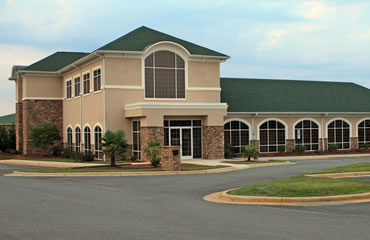Texas Is ‘Going Big’ In Biopharma
Texas wants to get the word out: It’s not just for oil and pipelines anymore.
The Lone Star State is a rapidly emerging biopharma hub, with more than just a lone focus on oncology. Houston and Austin are home to some of the top up-and-coming biopharma companies, and real estate powerhouses like Hines are anchoring major new developments with them.
Ridgeline Therapeutics is one such company, established in 2012 and spun out of technology invented by founder and CEO Stan Watowich at the University of Texas Medical Branch. Ridgeline develops small molecule inhibitors of nicotinamide N-methyltransferase (NNMT) to reverse Type 2 diabetes, obesity, muscular dystrophies and sarcopenia (age-related muscle degeneration).
During the past year, the company has begun to ramp up, hiring, applying for funding, developing the program and advancing projects closer to IND filing and clinical trials. How has their residence within JLABS@TMC, part of the Johnson & Johnson Innovation-JLABS incubator ecosystem, helped during this year of rapid acceleration?
“Working in Houston, for a biotech company, I think is great,” Watowich said. “The ecosystem, it’s not small, but it’s not out of control, so you can actually get to know many of the other companies, the other CEOs, see what they’re up to, share ideas, thoughts…the even bigger thing is you have access to all of these academic labs.”
Texas, and Houston in particular, has certainly caught the attention of the real estate development market. Audrey Symes, Director of Research, Healthcare, Life Sciences and Advisory at JLL, an American commercial real estate services company, explains why the city is at the top of their up-and-coming markets list.
“There are a couple markets that are right at the gate, ready to go, but I would say that the number one that is really emergent right now is Houston,” Symes said. “Houston has an amazing network of both medical practitioners and incubators, universities such as Baylor [The Baylor College of Medicine], the Texas Medical Center, and MD Anderson I think is the premier cancer research hospital in the US if not the world. So Houston has been really at the precipice of rising into the next rank for quite some time.”
Academic institutions rounding out the illustrious network include Rice University, The University of Texas Health Science Center at Houston, Texas A&M University, and The University of Texas Southwestern Medical Center in Dallas.
“You have a lot of idea flow coming out of this, and a lot of people thinking about starting companies,” Watowich explained.
With the commanding presence of the MD Anderson Cancer Center, the largest cancer center in the U.S., and one of the most preeminent in the world, the assumption would be that oncology is the state’s number one focus. According to Watowich, it is only at the center of a wide range of therapeutic passions:
“I would say oncology is definitely a strength in the medical center,” said Watowich. “Because you have MD Anderson, you have the Baylor college of medicine, you have some of the hospitals with their specialized care. But I would say neurological diseases are a strength, metabolic diseases are a strength, muscular diseases are a strength…it’s hard to say where there’s not a strength.”
Hines is a privately owned global real estate investment, development, and management firm traditionally known for its office spaces. The company has been diversifying significantly during the past decade, and two of their key focus areas – life sciences and senior living– mirror two of society’s biggest current priorities: healthcare and the rapidly aging population.
In July, Hines finalized a deal with 2ML Real Estate Interests to build a mixed-use life sciences and technology-based development called Levit Green, next to the Texas Medical Center. The company plans to break ground on the phase I building in the third quarter of 2021 and complete construction in late 2022.
“It’s not often that an organization can have the opportunity to develop 50 plus acres adjacent to the largest medical center on the planet. That opportunity came along, and we thought it was absolutely intuitive that you could marry up that type of opportunity next to something like the Texas Medical Center,” said John Mooz, a senior managing director, and market head of Houston/Austin/San Antonio at Hines.
For industry and real estate developers alike, the cost of building, and cost of living can often make the difference when deciding where to locate.
“In our trying to understand what the best end-users are for Levit Green, I do think they will be both organically from here, but also locating from either coast where among other things, it’s expensive to build relative to Houston,” Mooz said. “You have gross rates that top $100 psf, and Houston can be almost half of that. And when you’re looking at a company with early-stage funding, that can be a huge difference. So I would argue that Houston can attract top talent and top organizations with an incredibly affordable quality of life, and strong diverse, cultural offerings. With the global oncology pharmaceutical market projected to be worth approximately $200 billion by 2023, Houston is primed to move to the top of any emerging life sciences cluster list. That’s a pretty strong trajectory in a place that spends a lot of time studying cancer. You combine it next to a medical center that has over 9,200 beds, and we have, by anyone’s count, somewhere in the order of 1100-1200 clinical trials going on right now.”
For all of its merits, Texas is still growing into the biopharma mentality when it comes to capital investment.
“Where Texas really falls behind is capital,” Watowich said. “It’s not that they don’t have money…most of the money is from pipeline and it’s hard to get them to understand that investing in biotech per se isn’t really that different from doing a very deep offshore oil well. The risks are comparable, the timeline’s comparable, and the money’s comparable.”
Watowich is working with other Houston and Texas leaders to launch the Accelerator for Cancer Therapeutics. This Accelerator will assist entrepreneurs aiming to turn their research discoveries into clinical-stage biotech companies supported by forward-thinking investors and non-dilutive funding.
“People need to be willing and accepting of taking risks. And culturally, that doesn’t happen everywhere,” said Travis McCready, Executive Director, U.S. Life Sciences Markets at JLL. “The three mega markets that exemplify this are greater Boston, the Bay area, and San Diego. They (Houston) have a really glowing and exciting creative scene, and I like the creative economy as a measure and metric of risk.”
“The other key for Texas is an injection of privately-led development dedicated to the life sciences market, Mooz said. “Texas Medical Center, I believe is the eighth largest business district in the United States, and the work and the development that’s gone on there is astounding. It’s mostly by in-place organizations and not privately-led development, and that’s what’s been missing. I think what we really need is purpose-built facilities to accommodate all of that R&D, and that’s what we’re trying to answer.”
Source: BioSpace




